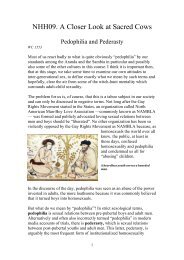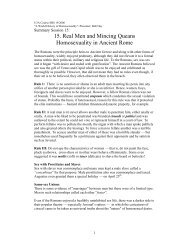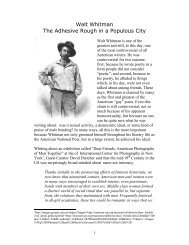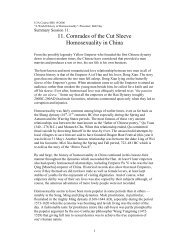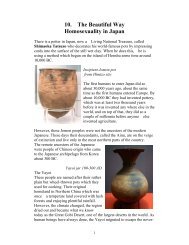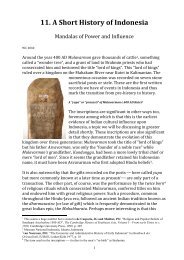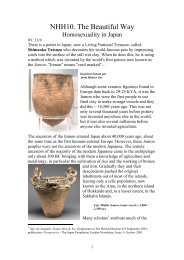7. Boy Wives of the Aranda The Pre-History of ... - BobHay.net
7. Boy Wives of the Aranda The Pre-History of ... - BobHay.net
7. Boy Wives of the Aranda The Pre-History of ... - BobHay.net
You also want an ePaper? Increase the reach of your titles
YUMPU automatically turns print PDFs into web optimized ePapers that Google loves.
<strong>the</strong>y had high-pitched voices and some form <strong>of</strong> language so <strong>the</strong>y might<br />
even have been able to sing albeit to our ears, falsetto. It is not known if<br />
Neanderthals and our ancestors, Homo sapiens sapiens, were able to mate<br />
with each o<strong>the</strong>r. Most scientists believe <strong>the</strong>y could not or if <strong>the</strong>y could,<br />
<strong>the</strong> <strong>of</strong>fspring would have been sterile, as mules are today. If by some<br />
chance <strong>the</strong>y were able to mate properly with modern man and pass on<br />
some genes, <strong>the</strong>n <strong>the</strong>re is an argument that we have inherited red hair<br />
from <strong>the</strong>m!<br />
<strong>The</strong> last Neanderthal died sometime between 29,000 and 25,000 years<br />
ago, many scientists suggesting that our ancestors ei<strong>the</strong>r killed <strong>the</strong>m<br />
directly in fights, or indirectly by depriving <strong>the</strong>m <strong>of</strong> living space.<br />
<strong>The</strong> Year Dot 1<br />
It was something like 4 million years ago that some chimpanzee-like<br />
ancestors <strong>of</strong> ours started walking on <strong>the</strong>ir hind legs. <strong>The</strong> upshot <strong>of</strong> this<br />
was that <strong>the</strong> upright stance hid <strong>the</strong> female genitals from view while at <strong>the</strong><br />
same time <strong>the</strong> buttocks grew larger. Breasts developed in females, body<br />
hair started to disappear, especially in females, while what had been, in<br />
earlier species, a very large clitoris grew smaller. Among males, <strong>the</strong><br />
miniscule penis <strong>of</strong> earlier models thankfully grew larger…<br />
While simply standing up hid <strong>the</strong> female genitalia, <strong>the</strong> o<strong>the</strong>r changes are<br />
difficult to explain as a response to some external challenge — for<br />
example, to prolonged drought or o<strong>the</strong>r climate change. Darwin himself<br />
recognized that many <strong>of</strong> <strong>the</strong>se changes in early man made no sense in<br />
terms <strong>of</strong> survival <strong>of</strong> <strong>the</strong> fittest and he postulated “sexual selection”, a<br />
process he argued had as much influence upon evolution as<br />
environmental pressures. This is <strong>the</strong> process <strong>of</strong> mate selection which has<br />
resulted in <strong>the</strong> peacock’s glorious but o<strong>the</strong>rwise useless tail which, in<br />
simple survival terms might even be a liability. However, it turns <strong>the</strong><br />
female on and she selects <strong>the</strong> male she considers to have <strong>the</strong> best tail…..<br />
When females started to walk upright, not only was <strong>the</strong> focus <strong>of</strong> attention<br />
shifted from buttocks and estrous labia to breasts but it also changed <strong>the</strong><br />
shape <strong>of</strong> <strong>the</strong> pelvis and birth canal so that childbirth became more painful<br />
and dangerous. This too does not make sense in terms <strong>of</strong> simple<br />
Darwinian selection but it did make sexual selection more important in<br />
directing <strong>the</strong> development <strong>of</strong> <strong>the</strong> human race. Walking upright freed <strong>the</strong><br />
hands to make and use tools, although <strong>the</strong> tools used by <strong>the</strong> earliest<br />
1 For much <strong>of</strong> this section I am indebted to Timothy Taylor: “<strong>The</strong> <strong>Pre</strong>history <strong>of</strong> Sex:<br />
Four Million Years <strong>of</strong> Human Sexual Culture”, Fourth Estate, London 1996, Pp 4 ff.<br />
2



